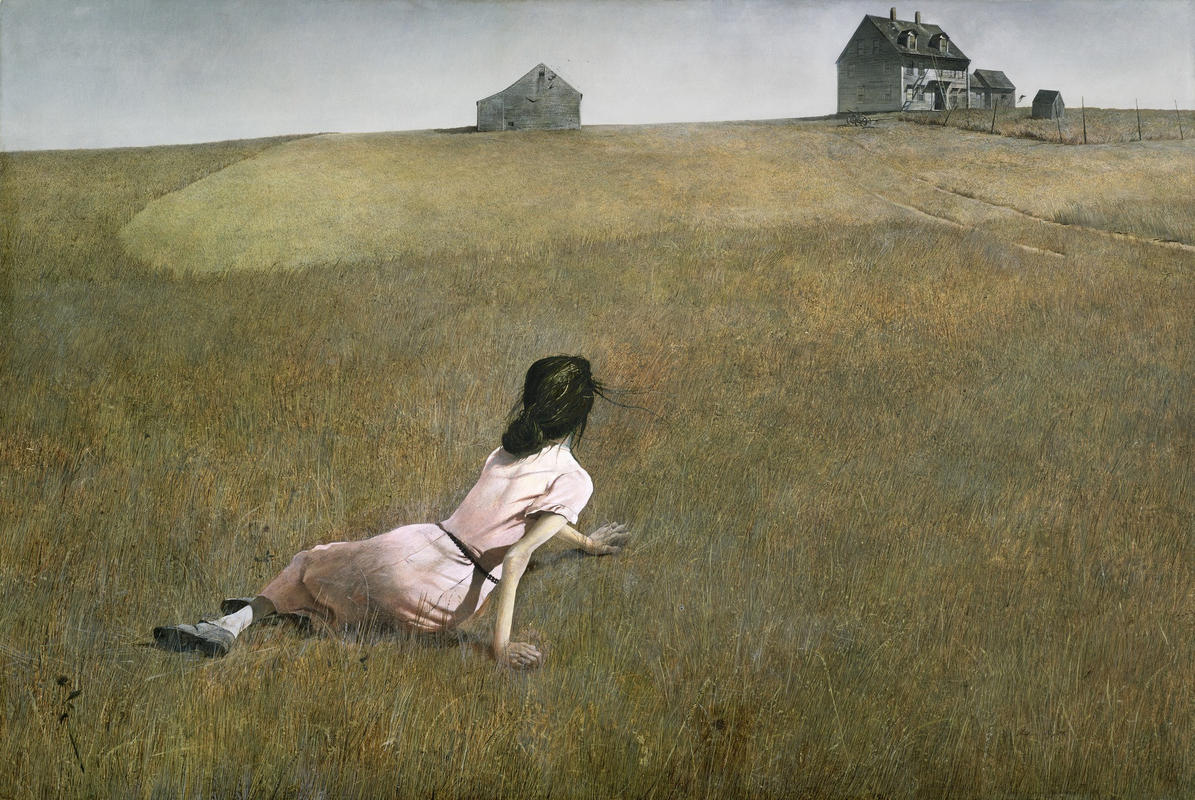More about Christina's World

Contributor
Wyeth's Christina's World goes from super depressing to one of American's most beloved works.
Wyeth captured that undeniable truth that many single girls know: don’t give it all up at once. If you retain an air of mystery, it will keep them coming back for more. This cunning piece of advice is surely why Christina’s World is one of American art history's most beloved works, for almost 70 years have gone by since its creation yet people are still wondering, who the heck is Christina?
Real talk: I always thought this painting was a tad depressing. The dull palette, a decrepit farmhouse, and a reticent woman all conjure up somber feelings. Turns out that while this painting is definitely depressing, it's not how Wyeth saw it. To understand Wyeth’s infatuation with Christina Olson, we must start at the beginning. Christina and Wyeth’s wife Betty were old friends. Trying to test the waters of their budding romantic relationship, Betty took Wyeth to Christina’s ramshackle farmhouse just to see if he would go in; essentially she was trying to feel out how judgmental he was as Christina and her home were far from appealing. In fact, rumor has it that Christina’s home was so dilapidated and encrusted with years of grime that when actor Robert Montgomery went inside, he ran from the house and vomited after being inside just a few minutes. Yuck.
Wyeth on the other hand, could not get enough of Christina. See, Mrs. Olson was a captivating character who suffered from polio, rendering her a paraplegic. Christina was a woman of honor and incredible stubbornness, and rather than spending her life chained to a wheelchair, she chose to drag herself around on the ground instead. This leads me to believe that her upper body must have been yoked and her hands callused - my type of woman. It was not just her odd decision to boycott wheelchairs that infatuated Wyeth so; it was her spirit. As Wyeth explained, she “was limited physically but by no means spiritually...The challenge to me was to do justice to her extraordinary conquest of a life which most people would consider hopeless." An endearing outlook on a bleak situation. It was her drive, passion, and yearning for a normal life that captivated Wyeth and countless others who have stood before Christina’s World.
Wyeth was a simple man. Almost his entire portfolio comes from two places: Chadds Ford, Pennsylvania, where he was born, and South Cushing, Maine, where his wife owned a home next to Christina Olson. Furthermore, he primarily painted only two families, one of which was the Olsons depicted here. So much for variety being the spice of life. Nonetheless, Christina was the star of many of Wyeth’s paintings, and as their friendship grew, she even let him use one of the upstairs rooms in her house as his studio.
The MoMA acquired this work less than a year after Wyeth completed it for a whopping $1,800 smackaroos. Now holding the title of Wyeth’s most iconic work and one of the most recognizable American paintings, it's safe to say the MoMA is probably pretty smitten with their decision to dish out the big bucks back in the day. Turns out at the time, Christina’s allure had yet to tantalize the populace, for the reception of this painting was tepid to say the least. Wyeth himself even saw the work as “a complete flat tire”. I guess wine isn't the only thing that gets better with age.
Sources
- New Republic, https://newrepublic.com/article/118588/andrew-wyeths-christinas-world-c…
- MoMA, https://www.moma.org/collection/works/78455?locale=en
- New York Times, http://www.nytimes.com/2009/01/17/arts/design/17wyeth.html?_r=3&pagewan…
- MoMA, https://www.moma.org/explore/inside_out/2012/11/21/a-closer-look-at-chr…
- Farnsworth Museum, http://www.farnsworthmuseum.org/olson-house
Featured Content
Here is what Wikipedia says about Christina's World
Christina's World is a 1948 painting by American painter Andrew Wyeth and one of the best-known American paintings of the mid-20th century. It is a tempera work done in a realist style, depicting a woman in an inclined position on the ground in a treeless, mostly tawny field, looking up at a gray house on the horizon, a barn, and various other small outbuildings adjacent to the house. It is held by the Museum of Modern Art, in New York.
The painting was featured in the 1980 BBC Two series 100 Great Paintings.
Check out the full Wikipedia article about Christina's World












